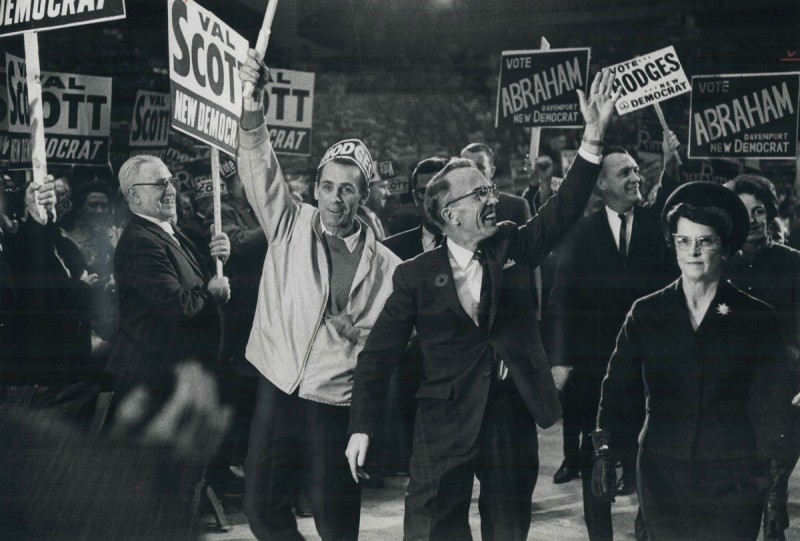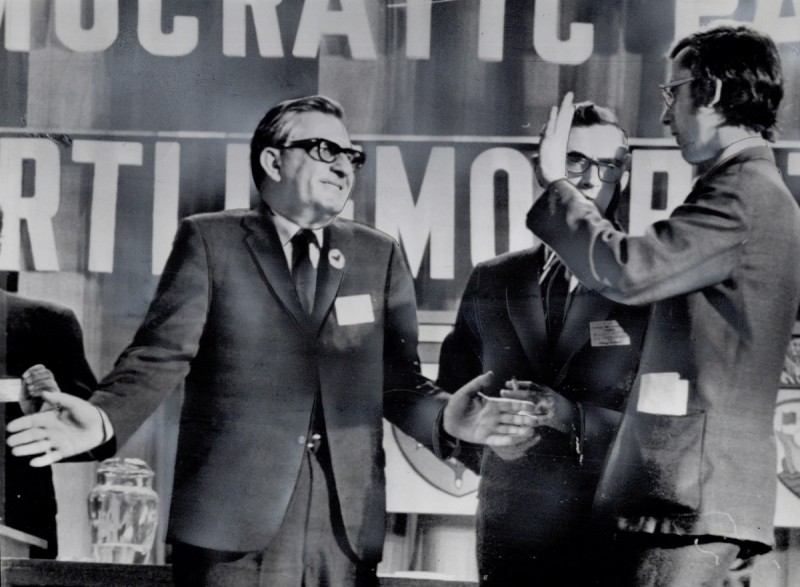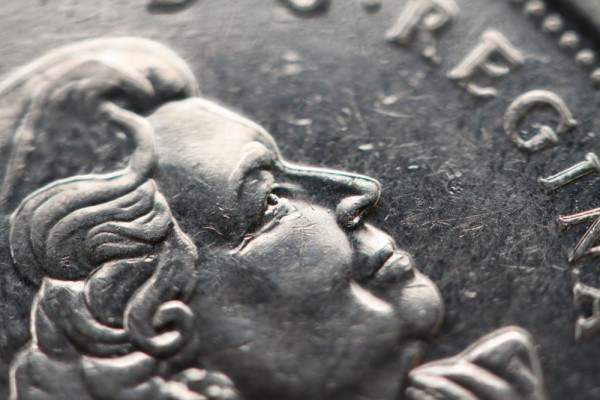Canada’s socialist legacy
From the August-September 1978 edition of CD

NDP Leader Tommy Douglas and his wife, flanked by enthusiastic followers, entering Maple Leaf Gardens for a rally, 1965. Photo courtesy the Toronto Public Library.
There is a great need today for Canadian socialists to come to terms with the legacy of ideas and organizations that form their heritage. We are faced with a serious bourgeois offensive against the working class in the aftermath of its defeat by wage controls. At the same time a confused and ideologically illiterate CLC leadership masks its incompetence with corporatist illusions. We see an NDP in which the leftist minority is hushed and without direction while the party leadership proudly (and accurately) portrays itself, in the immortal words of Stephen Lewis, as “sheep in sheep’s clothing.” The Canadian Communist Party continues to be politically ineffectual, while remaining one of the most staid and unimaginative CPs in the Western world.
How did we get here? What effects must our history have on a new generation of working class militants untouched by the crude anti-communism of the Cold War? What can those of us committed to the socialist project, to laying the groundwork for a viable mass, democratic, but revolutionary party learn from what our fathers and forefathers did? Serious inquiry into the history of the Canadian socialist movement will help us not only to learn from the mistakes of the past, but also to reclaim what is valuable from this history. Norman Penner’s book, seen in this light, is important and timely.
The main focus of the book is on the emergence and development of Canadian socialist thought. But as the author himself points out: “Though this book is primarily a study of socialist ideas in Canada, attention had to be given to the organizational contexts in which these ideas developed.” This intent, to relate ideas to the social forces and organizations out of which they arose, is one of the book’s outstanding attributes. All too often, the study of Canadian political thought, including socialist thought, has been undertaken in a social and political vacuum, treating ideas as disembodied spirits governing the behaviour of classes, parties and individuals rather than emerging out of class struggle. This, for instance, is the problem with the Hartzian model used by Gad Horowitz in his famous article on “Conservatism, Liberalism and Socialism in Canada.”
At the other pole, the study of working class parties in Canada has often tended to put too much emphasis on the organizational dimension; failing to treat seriously enough the ideologies of the parties in question. This is particularly true of Ivan Avakumovic’s The Communist Party in Canada, and even applies to Walter Young’s study of the CCF, Anatomy of a Party. Although Penner, as we shall see, does not in fact adequately relate his study of ideas to the organizational life of the CPC and CCF, he is to be applauded for his explicit attempt to do so.
The strength of this approach is immediately apparent in Penner’s first chapter, which provides an historical overview of the evolution of Canadian political thought from the 18th to the early 20th centuries. He relates this thought, in a most convincing manner, to the economic, demographic and political forces operating in Canadian society. This chapter alone is worth the purchase price of the book, serving as it does as a general introduction for socialists to the historical forces which shaped the conservative and liberal ideology we know.
Upon this solid basis, Penner moves to his examination of early socialist thought in Canada. Apart from providing the most accessible and complete (far more readable than Martin Robin’s Radical Politics and Canadian Labour) menu of socialist groupings in the first decades of this century, Penner creates here a real feeling for the intellectual and social ferment that engulfed so much of the working class in this period. The most striking sections deal with the years immediately following World War One and offer heady evidence of a class in the process of self-formation (in Montreal 3,000 people gathered in February 1918 to hear James Simpson on the Bolshevik revolution, while in Vancouver, Sunday evening meetings of the Federated Labour Party and The Socialist Party of Canada attracted such crowds in 1918 that four or five separate meetings had to be run simultaneously).
Penner’s most important contribution to an understanding of this period is to stress repeatedly that Canadian socialism was predominantly Marxist in ideology and overwhelmingly proletarian in composition. “For a considerable period,” Penner writes, “socialist theory, which subsumed political economy history, sociology and philosophy was propagated by a group of worker-intellectuals, who earned their living at their vocations, and who studied, wrote and taught Marxism in their spare-time.” Today, when so much is made of the need to develop what Gramsci called, “organic intellectuals” of the working class, but when precious little contemporary evidence for their emergence exists, Penner provides an important perspective. It is to be fervently hoped that Penner’s work will once and for all lay to rest the myth that Marxism has always been confined to the margins of Canadian socialism, that our roots are sunk in the barren soil of British Fabianism. It was only among traditional intellectuals that Marxism made no impact in these early years, but insofar as socialist thought influenced workers in this period, it bore a Marxist label.
Penner is careful, moreover, not to romanticize the worker-intellectuals of the early socialist movement. He is well aware of the positive features of “a body of men who were looked up to in the labour movement even beyond those who agreed with their socialist views. Their emphasis on education made them stand out among their fellow workers as exceptionally gifted people. At the same time it gave others a feeling of self confidence. After all, if their peers could master philosophy, history and economics, so could they.” But Penner does not ignore the disadvantages of a movement without the resources to sustain full-time intellectuals. “On the one hand, their writings and speeches tended to have an abstract and doctrinaire quality, repeating Marxist postulates over and over again, but giving little attention to the possible use of Marxism as an analytic tool for the critical study of Canadian society. Their writings were confined mainly to socialist and labour periodicals or small five and ten-cent pamphlets.” Significantly, the only major socialist work on Canada produced in this period was by the American, Gustavus Myers.
Tim Buck, long-time general secretary of the Communist Party of Canada.
However important these early chapters may be, there is no question that the true centrepiece of the book consists of Penner’s two subsequent chapters on the Canadian Communist Party from 1921 to 1957. The two dates are not only significant for the Party. They are significant for Norman Penner himself. Penner was born into a prominent Communist family in 1921, the year of the founding of the Party. In 1957, having risen to the top echelons of the Party hierarchy, he joined the mass exodus out of the Party, after having finally tried and failed to shake the Party from its Stalinist moorings in the aftermath of Khrushchev’s Twentieth Congress revelations. Clearly here is a man who can tell us a great deal.
Penner does not set out to write a history of the Party. He devotes himself instead to a detailed exposition of the Party’s ideological position on four central themes: the national question, French Canada, trade unions and social democracy. The main virtue of his approach is that he takes the Party’s ideas seriously, and thus provides us with the first comprehensive review of the CPC’s thought.
What we get from this review is a series of images of the Party. The first image is that of a Party which (with the exception of the ultra-left years of 1929 to 1934) always gave very great emphasis to the question of Canadian dependency. For those who think that left nationalism is a contemporary phenomenon this will be a salutary history lesson. Such was the emphasis Canadian Communists gave to the national question (in the 1920s they promoted an alliance between the American and Canadian bourgeoisies against Britain; in 1954, they laid a wreath at John A. MacDonald’s monument at Queen’s Park in Toronto), that Penner feels they came close to supporting bourgeois nationalism (a spectre the Party always sought to exorcize vis à vis Quebec nationalism, ironically).
But the second image qualifies the first and marks the Party off from much current left nationalism. It is the Party’s overriding commitment to addressing itself to the Canadian working class. Indeed where it differed from the Marxist parties that preceded it was in its greater success in organizing and mobilizing industrial workers. Unlike the earlier parties it regarded union work not as separate from Party work, but as an integral aspect of Party work. This approach entailed certain liabilities by limiting the autonomy of industrial struggle, but it was also a major source of strength. For through this indissoluble link in its activities, the Party implanted itself in the working class as a permanent fixture, tarnished, but never removed even in the face of the Party’s ideological shifts and electoral weakness, and in spite of the Cold War onslaught against it.
David Lewis, deputy leader of the New Democratic Party, faces Professor Melville Watkins (right), 1969. Photo courtesy the Toronto Public Library.
The third, and most powerful image, however, is that of a party whose ideology was characterized by its constant subordination of theory and revolutionary strategy to tactical considerations. As Penner makes clear, this was not a matter of praxis, of developing theory in light of experience in the class struggle. It was rather the pronouncement of universal theoretical absolutes, ostensibly good for all time and under all conditions, to suit immediate tactical objectives. And the tactical objectives were more often than not those of the Communist Party of the Soviet Union.
All the Parties of the Third International were treated as clients by the Soviet Party, in the most pejorative sense of the term “client.” The Canadian Party, however, was one of the most servile. Thoroughly schooled in the ideological cynicism and democratic centralism of Stalinism, the Canadian Communist Party, on every occasion of a significant change in its direction, changed on the basis of decisions made in Moscow.
These images are painted with careful detail by Penner. Moreover, Penner strives to include some positive commentary on the Party. Although he argues that the CPC failed to produce any major Marxist analyses of the Canadian political economy, he also argues that the Party alone managed to maintain a sustained Marxist critique in Canada over this long period. Although he is critical of the way in which the Party did a complete flip-flop on its trade union position in setting up the Worker’s Unity League, he (unlike Avakumovic) at least credits the WUL with major organizing accomplishments in the depths of the depression.
Most significantly, he recognizes that the Party leaders in Canada were not just automatons directed by Moscow. Although Tim Buck fell in line with “international discipline” on all major questions, he did so only reluctantly on the national question at the start of the ultra-leftist period in the late twenties, carrying on a struggle against the Moscow view that Canada was an “imperialist” country long after it was prudent, in Stalinist terms, to do so.
On occasion, however, Penner does seem to go too far in his critical attitude to the Party. He lays on it virtually all the blame for estrangement and hostility between the CP and CCF-NDP leadership, underestimating the petty anti-Marxism that so often motivated the latter. He also seems to have a particular blind spot (or sore spot?) for Stanley Ryerson. Penner makes a strained and carping criticism of Ryerson’s contribution in defining a serious (and indigenous) Marxist position on Quebec in the late 1930s and early 1940s.
But these are minor problems, and in general Penner’s account is balanced. If there is a major problem in Penner’s handling of the CP, it is in terms of his failure to adequately relate the ideology of the Party to its historical and organizational context. His thematic separation of Party thought means we rarely get an overall view of how these themes come together, of how the pieces fit into a whole. To take the example of the ultra-leftist period of 1929 to 1934, the Party’s treatment of Canada as “imperialist,” its decision to go it alone in its union work by setting up the WUL, its sectarian attacks on the emerging CCF, all these matters are treated separately in a disconnected manner. But all these positions were cut from the same cloth, a cloth produced in the satanic mill of the International’s Sixth Congress in 1928 which initiated the tragic “social fascist” line against alliances between Communists and reformers. Penner does not address this basic shift in policy until he comes to deal with the CP and the CCF in the last section of his account. Thus, not only are we introduced to the shifts that occurred on the national question and on the trade unions in an extremely partial way, but we are never, even in the last section, given a systematic account of how the various themes Penner addresses were integrated in the Party thought as a whole in this period. A reader without much knowledge of the history of the Comintern, the very reader to whom the book appears to be addressed, would be left somewhat confused and perplexed as to the reasons for the substance and timing of the various changes and how they were interwoven.
A second, and related, failing is that Penner pays too little attention to the historical events to which the Party responded in changing its tactics, and to the events of the Party’s organizational history itself. Crucial debates are suspended in mid-air without any basis for the reader to assess their judiciousness, or Penner’s criticism of them. Above all, since Penner correctly maintains that the policy of the Canadian Communist Party changed in light of international decisions, we are sorely in need of some location of changing Comintern positions in their overall historical context. If Canadian Party leaders were not mere robots, but were to some extent convinced of Moscow’s arguments, an account of their behavior is only comprehensible in the light of an insight into the events and arguments in Moscow to which they were responding. So much is this lacking that even Penner’s cut-off date, 1957, is never explained at all to the reader. We are told nothing of Khrushchev’s speech, nothing of Hungary, and nothing of the Canadian Party’s traumas in 1956 and 1957. To the layman, 1957 will appear as nothing more than an arbitrary cut-off point, not a year full of historical meaning for the Canadian Communist Party, and Norman Penner personally.
The greatest flaw of all, which arises out of this approach, is that discussion of internal Party organization is largely absent from the book. There is general reference made to Stalin’s type of democratic centralism; a comment on how the Party tended to confuse party and union work; and a short account of what theory Party cadres were reading (predominantly Stalin’s Foundations of Leninism). But we learn very little about the organization of the Party, the size and composition of its membership, how these changed over time, and how organization and ideology are linked. We don’t know if ideological shifts have a functional or dysfunctional effect on concrete Party work.
To take one example, the “social fascist” line of the early 1930s is properly attacked by Penner, but he does not ask why, with such a weak ideological position, Party members threw themselves with such fervour and success into union organizing, agitprop theatre, and so on. Is there a connection between the adventurist ideas and organizational dedication and activity? Could it be that members found the adventurist ideology liberating in terms of Party work? Or was it rather the economic and cultural conditions of the depression that set Party members off in imaginative and effective ways among the people? In which case, the change in ideology may not have mattered much and we have been chasing a chimera. I don’t know the answer to these questions. That Penner’s book stimulates them is to its credit. That it doesn’t give much help in answering them, is not.
How did Party members themselves perceive the theoretical debates and shifts at the top? Avakumovic quoted a leading Party member, J.M. Clarke, writing in 1929 of the stream of circulars, directives and manifestos that flowed from Party Headquarters: “Words, words, words. Oceans and oceans of empty verbosity. Millions of trolops, reams of junk, hours of scatter-brained blah that in no way indicates the slightest understanding of conditions as they actually exist out in the country and out among the rank and file of the workers.”
Tim Buck (left) and others, Dominion Communist – Labor Total War Committee meeting, Maple Leaf Gardens, October 13, 1942. Photo from Wikimedia Commons.
Penner’s own critique of the Party for its failure to produce concrete Marxist analyses of the Canadian political economy captures this problem, although in less graphic form. Yet what we need to know is how widespread was this feeling among Party members themselves? How precisely did it affect Party work? To what extent was it a product of lack of trust in the working people or even the average Party member? Was it an underestimation of their capacity to understand questions of theory and strategy, or was it a fear of the consequences for the Party leaders of the development of critical faculties at the base of the Party?
Again, I can’t answer these questions, although I have some hunches. Reading a book like Oscar Ryan’s recent biography of Tim Buck one gets a feeling that Party members are (and were?) being exposed to a mode of thought not unlike that of Reader’s Digest, however much the content differs. Ryan’s sycophantic biography sounds like nothing so much as Reader’s Digest’s “My Most Unforgettable Character” feature. The parallel is not a random one for me. I am very close to an elderly working class woman who was a Party member in the Thirties, and who remains fully sympathetic to the Party today (and only slightly less so to the USSR). She retains the fighting spirit of her earlier days, and has a fine basic understanding of the Marxist theory of exploitation and surplus value. Her favourite magazine is Reader’s Digest. How does one get a handle on this paradox? Did the Party contribute to producing the welter of ideological contradictions which she represents?
Penner should be able to give us some insight into working class culture and the Party’s relation to it in terms of those it touched. If he does not, it may well be because it involves a larger and deeper project than he set himself in the book. For this one can’t fault him. But his failure to adequately marry ideology and organization may also lie in his belief that, “The problem of winning Canadian workers to socialism was an ideological rather than an organizational one.” What can this possibly mean, particularly in light of Penner’s introductory remarks on the need to study ideas in relation to their organizational context? Does it mean that the influence of Stalin was solely at the level of his mode of thought, but not at the level of party organization? Does it mean that the slavish following of Moscow’s line was a product of emotional attachment or logical reasoning but not of the centralized structure of the international and the financial dependence of the Canadian Party? If organization doesn’t matter, why emphasize the confusion between union and party work? The distinction is untenable and much of Penner’s own evidence contradicts it.
What Penner appears to mean is that the ideological problem of the CP was that it was revolutionary when the Canadian working class was reformist. The CPC, Penner says in his conclusion, “was faced with the problem, which it was never able to solve, of defining a role for a revolutionary party without immediate or even longer-term revolutionary prospects.” A commonplace view, reflecting a serious problem. But Penner never suggests that there is a way to solve the problem except for the Party to become reformist. Social Democracy, he tells us, reflects “fairly accurately the level of class consciousness which the radical section of the working class and middle class has attained. It represents the spontaneous striving of these people toward a form of socialism.” And moreover, “Social Democracy develops in those capitalist societies where the opportunity still exists for reforms of a major character.”
The implications of this are clear. We have here a form of determinism no less fatalistic than its orthodox Marxist variant. It traces its root to Bernstein and pre-World War One German Social Democracy (hence the need to know how much of it was around in Canadian Marxism at the beginning of the century). What it tells us is that, in the final analysis, different forms of revolutionary party organization don’t matter (Stalinism itself doesn’t matter!); party education of the working class doesn’t matter; Parliamentary versus extra-parliamentary activity doesn’t matter; class struggle versus class collaboration strategies don’t matter. What matters is some hidden social mechanism, beyond the activities of men, that determines whether or not revolution is “on the agenda.” History conceived as men making history gets short shrift.
Penner’s chapter on the “roots of CCF thought” which follows his chapters on the CP, bears the marks of this outlook. He examines the early ideas of the founders of the CCF (primarily that of Woodsworth) to show the anti-capitalist strain in Canadian social democracy. This serves to refute the “social fascist” line, and is useful at that level, as well as against contemporary ultra-leftists who cannot bring themselves to recognize the NDP’s working class base and radical intellectual origins. But what Penner does not succeed in doing is to demonstrate that social democratic reformism is the spontaneous and accurate reflection of the working class in Canada. Reformist practice (here Lenin was wrong) is not spontaneous, it is learned as much as any other practice. To be sure, it is more easily learned than revolutionary practice since the penalties against the latter are great and since the former is compatible with the existing institutions of bourgeois hegemony.
The CCF-NDP has been involved throughout its history in teaching that reformism (more than the CP ever taught revolutionary practice, I would suggest) in innumerable abstract and concrete ways. To see, as Penner does, the CCF-NDP as the inheritor of the Marxism of the socialist parties before 1920 either proves that these parties were already reformist by this time (and hence on their way, like German Social Democracy, to abandoning Marxism), or had never been predominantly Marxist (like the British Independent Labour Party). The interesting question is not whether social democratic reformism is “bourgeois” or “social fascist.” Of course, it is neither. The interesting question is whether social democracy inculcates the working class with values and institutions conducive to class struggle and to bringing the working class to power. The gradualness of this project is not the issue. From Engels to Gramsci to a large component of the Italian Communist Party today, revolutionary Marxists have often chosen the gradual path in appropriate (i.e. liberal democratic) conditions. The question comes down to whether the path leads to working class hegemony over society. If Canadian social democracy is one of the paths to socialism, as Penner maintains, rather than an alternative to socialism as the NDP presents itself today, Penner certainly never tells us why.
Perhaps we would have a clearer picture of Penner’s position if he focused detailed attention on the contemporary CP and NDP, rather than on their roots. Unfortunately he ends his book only with a superficial review of the new left groupings that have developed in French and English Canada over the last two decades. Instead of adding these new dishes to the menu of left groupings, what was needed was an assessment and comparison of the CP and NDP in light of their current thought and practice and the connections with their history. Given Penner’s faith in social democracy, he may have to address the NDP first to sustain his arguments in this book But one gets the feeling that where he could really make a further contribution would be in studying the contemporary Canadian Communist Party, perhaps in comparison with other western CPs. This would require beginning with the Party’s trauma of 1956-7 (in organizational as well as ideological terms). Penner should be capable of doing this. Perhaps he will—someday.
This article originally appeared in Canadian Dimension, Volume 13, No. 3 – August-September 1978.
Leo Panitch (1945-2020) was emeritus professor of political science at York University, co-editor (with Greg Albo) of the Socialist Register and co-author (with Sam Gindin) of The Making of Global Capitalism (Verso).










